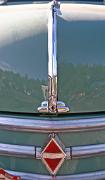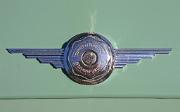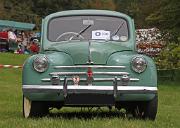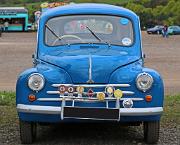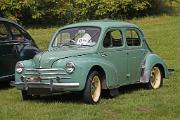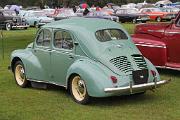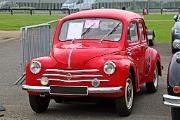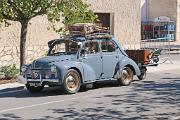
Renault 4CV 1952 towing
Renault 4CV 1952. Still with the 6 bars on the front grille (until 1954) and detachable wheel rims
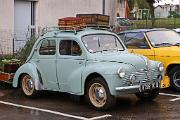
Renault 4CV 1953 frontg
Renault 4CV 1953. The 6-bar 'moustache grille' was simplified to 3 bars in 1954
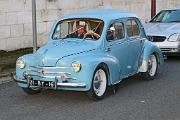
Renault 4CV 1955 frontb
Renault 4CV 1955. In late 1954 the '6-bar moustache' front grille was simplified to 3 bars
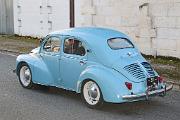
Renault 4CV 1955 rearb
Renault 4CV 1955. The rear of the 4CV didn't change much, the indicators on the c-pillar remained until about 1960.
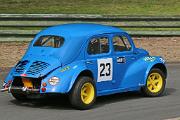
Renault 4CV 1956 racer23
Renault 4CV 1956, 1565cc. The Renault 4CV was used in competition from the start of production and was quite successful in the 750 class. This example has an engine twice the original specification.
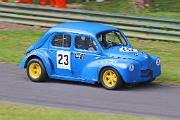
Renault 4CV 1956 Racing
Renault 4CV 1956 Racing. with 1,565cc engine
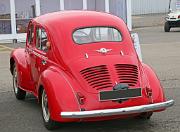
Renault 4CV 1961 750 rearr
Renault 4CV 1961 750. The Renault 4CV was sold as 'Renault 750' in Britain and cars were assembled from imported parts at a factory in Acton, London.
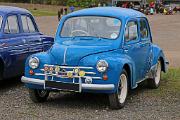
Renault 750 1956 front
Renault 750 1956. The Renault 4CV was assembled at Acton in North London and sold as the 'Renault 750'

s Renault 4CV 1953 side
Renault 4CV 1953. This 'Beetle' shape was reviewed by Ferdinand Porsche prior to production because he was a prisoner on collaboration charges. The shape was actually nicknamed 'la motte de beurre' as the first cars were a shade of light yellow and were said to look like a 'mound of butter'.

s Renault 4CV 1954 with trailer side
Renault 4CV 1954 with trailer. The one-wheel trailer is probably unique to France.
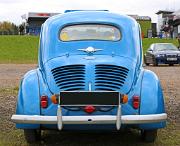
t Renault 750 1956 tail
Renault 750 1956. Renault assembled the Renault 4CV at Acton in North London and sold it as the 'Renault 750' with the 747cc engine
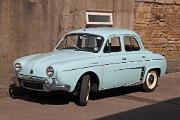
Renault Dauphine 1958 front
Renault Dauphine 1958. Though intended to replace the 4CV in 1956, it was conceived as a 5CV car and the 4CV was not retired until 1960. The Dauphine was given a conventional 3-box body, losing the beetle-back of the 4CV
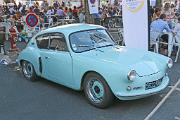
Alpine A106 1956 Mille Miles front
Alpine A106 1956 Mille Miles. Production commenced in 1955 of the Alpine A106, and following a class win in the 1956 Mille Miglia race, a 'Mille Miles" option was available with quadruple rear shock absorbers and a rare 5-speed gearbox.
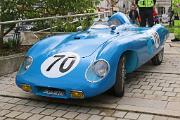
Ferry 750 1955 front
Ferry 750 1955. Pierre Ferry built this Sports Car in 1955 using a Renault 750cc motor and an aluminium body. It was 2nd in the 750 class for the Paris 1000km 1956, 1st in Class 1956 Reims 12 hours, 2nd in class 1956 Normandy GP, and won its class at 1956 Mont Ventoux, and two other races. Then it was sold to a Renault importer in California where it won many races and then vanished. The car was rediscovered after the millenium and restored
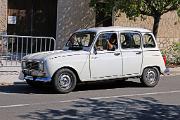
Renault 4 TL 1986 Savane front
Renault 4 TL 1986 Savane. From 1986 the Renault goes into wind-down of production and the basic Renault 4 stops production. Both the 4 TL and 4 GTL continue, but now with the Cleon 956cc engine for the 4 TL (now named 'Savane') and 1.108cc for the 4 GTL (now named 'Clan') until production ends in 1992
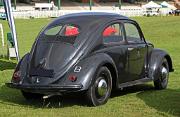
Volkswagen Beetle 1949 11C rear
Volkswagen 11C 1949. click here: for pages on Beetle-shaped cars.
All images and content of this site is the copyright of Simon GP Geoghegan
